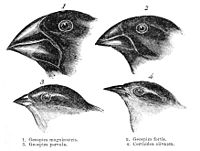
Photo from wikipedia
The role of recombination in genome evolution has long been studied in theory, but until recently empirical investigations had been limited to a small number of model species. Here we… Click to show full abstract
The role of recombination in genome evolution has long been studied in theory, but until recently empirical investigations had been limited to a small number of model species. Here we compare the recombination landscape and genome collinearity between two populations of the Atlantic silverside (Menidia menidia), a small fish distributed across the steep latitudinal climate gradient of the North American Atlantic coast. We constructed separate linkage maps for locally adapted populations from New York and Georgia and their inter-population lab cross. First, we used one of the linkage maps to improve the current silverside genome assembly by anchoring three large unplaced scaffolds to two chromosomes. Second, we estimated sex-specific recombination rates, finding 2.3-fold higher recombination rates in females than males-one of the most extreme examples of heterochiasmy in a fish. While recombination occurs relatively evenly across female chromosomes, it is restricted to only the terminal ends of male chromosomes. Furthermore, comparisons of female linkage maps revealed suppressed recombination along several massive chromosomal inversions spanning nearly 16% of the genome. These inversions segregate between locally adapted populations and coincide near perfectly with blocks of highly elevated genomic differentiation between wild populations. Finally, we discerned significantly higher recombination rates across chromosomes in the northern population compared to the southern. In addition to providing valuable resources for ongoing evolutionary and comparative genomic studies, our findings represent a striking example of structural variation that impacts recombination between adaptively divergent populations, providing empirical support for theorized genomic mechanisms facilitating adaptation despite gene flow.
Journal Title: Molecular ecology
Year Published: 2022
Link to full text (if available)
Share on Social Media: Sign Up to like & get
recommendations!